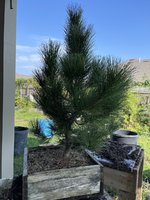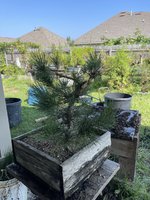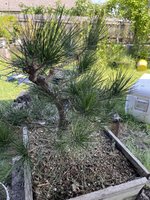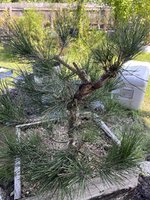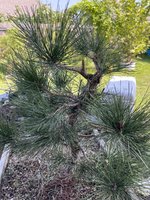You are using an out of date browser. It may not display this or other websites correctly.
You should upgrade or use an alternative browser.
You should upgrade or use an alternative browser.
I don’t know what I am doing with JBP
- Thread starter Cajunrider
- Start date
namnhi
Masterpiece
Uncle,
Very healthily and looks like you have a lot of branches to pick from which is good. I think you need to decide what you want to do with the top two somewhat large branches. Keep one small for apex while leave the other as sacrificial branch? I think this will be a medium tree so the lowest branch seems too low for me... The middle section still seems to have too many branches which I think you could thin out a bit there. Should be a fun tree for you to enjoy styling. Shape it in a way pleasing to your eyes.
Very healthily and looks like you have a lot of branches to pick from which is good. I think you need to decide what you want to do with the top two somewhat large branches. Keep one small for apex while leave the other as sacrificial branch? I think this will be a medium tree so the lowest branch seems too low for me... The middle section still seems to have too many branches which I think you could thin out a bit there. Should be a fun tree for you to enjoy styling. Shape it in a way pleasing to your eyes.
Gabler
Masterpiece
Deciduous trees make intuitive sense to me. Grow them out, increase vigor, chop them back, repeat to build taper from the base of the trunk through the branches.
Evergreen conifers do not make as much intuitive sense to me. You can't chop them. You need to use sacrifice branches to build girth, but also balance the vigor so the lower branches don't become too weak, but also keep them from getting too lanky, with foliage too far from the trunk. It's proven to be a tricky balance for me to strike.
Anyway, my point is that there's only so much I've been able to glean from videos and progression threads, and I'm interested to see what everyone recommends for this particular tree.
Evergreen conifers do not make as much intuitive sense to me. You can't chop them. You need to use sacrifice branches to build girth, but also balance the vigor so the lower branches don't become too weak, but also keep them from getting too lanky, with foliage too far from the trunk. It's proven to be a tricky balance for me to strike.
Anyway, my point is that there's only so much I've been able to glean from videos and progression threads, and I'm interested to see what everyone recommends for this particular tree.
MaciekA
Shohin
I think pine bonsai growing internet culture on forums has a very strong "Just let it grow" element to it. Meanwhile though, pros and experts are doing a lot to evolve material ("add information" as Hagedorn says) even in or especially in early development, so by the time they get to a tree a certain no-backsies heft, there are enough established aspects of the tree to still pull off the original hoped-for design and size.
Certainly in expert's trees, the smaller the intended design size is, the less likely they've let it blow certain past points of no return for wiring branches down and starting on ramification. When I spent a few days with Daisaku Nomoto at LeftCoastBonsai last winter, one of his most scathing (and oft-repeated, as we worked through various species) criticisms of American and western bonsai was that we are starting on ramification far far far too late and ending up with leggy trees as a result. It could be part of the reason why shohin pines are kinda rare in this country -- you gotta be on top of things from year one and most of us are on year X + 5 before we realize what we're supposed to have been doing thus far ... I learned this the hard way, but as Hagedorn says, if you miss the window for one size, just go to the next size up. A lot of my early pines are gonna be some big-ass pines, but the last few years it's all shohin or as small as I can get (albeit with tall sacrificial leaders).
... I learned this the hard way, but as Hagedorn says, if you miss the window for one size, just go to the next size up. A lot of my early pines are gonna be some big-ass pines, but the last few years it's all shohin or as small as I can get (albeit with tall sacrificial leaders).
For me the off ramps for design options or size classes of pines are "kept in play" or kept available by:
The following will assume a single trunk design. If this was my tree I would:
Certainly in expert's trees, the smaller the intended design size is, the less likely they've let it blow certain past points of no return for wiring branches down and starting on ramification. When I spent a few days with Daisaku Nomoto at LeftCoastBonsai last winter, one of his most scathing (and oft-repeated, as we worked through various species) criticisms of American and western bonsai was that we are starting on ramification far far far too late and ending up with leggy trees as a result. It could be part of the reason why shohin pines are kinda rare in this country -- you gotta be on top of things from year one and most of us are on year X + 5 before we realize what we're supposed to have been doing thus far
For me the off ramps for design options or size classes of pines are "kept in play" or kept available by:
- Holding back or hacking back (decandle or cut-to-a-needle) future "keep branches" while meanwhile allowing (a) sacrificial leader(s) to absolutely surge upwards/outwards
- Solo'ing out or simplifying and "poodling" (necking up, whatever) the sacrificial leaders
- Wiring branches down as much as possible, wire it all, wire often. Wiring is life.
- Wiring trunk lines and extensions to the trunk line every year, starting as early as physically possible (year 1 if the potting allows)
- Getting a front and angle set early so that all downstream-dependent decisions are more accessible without awkward operations
- Never allowing any piece of growth to remain "long, strong, straight & boring, elder, exterior to the design" for long.
The following will assume a single trunk design. If this was my tree I would:
- Find the best front and best front angle (even if you've found it before, good to review in light of where branching is today)
- Prop up the tree to that best front and angle so it can stay in that position until the next repot window.
- Now that the base of the trunk is in position, find the best or "currently-favored" trunk line from base to tip -- doesn't matter if today's favored tip is not the ultimate apex or tip forever -- the tree should have a big running sacrificial leader to keep thickening anyhow.
- Now that the trunk line is chosen from base to tip, everything else is either a current/future-cued-up sacrificial runner, a primary branch, or some pretender-to-the-throne alternative trunkline. Things identified as branches get wired down to descend quickly with slightly upturned tips. Pretenders (i.e. wanna-be alternative trunk lines that lost the contest for which trunkline is best) are marked for future shortening or removal, but if the plan for them is shortening, then that'll be a branch. If it becomes a branch it should get wired down as much as is possible.
- (edit, I initially forgot this) In the above step, whorls shoud be resolved down to 2-junctions. Remove excess branches. Keep the most promising growth -- short first internode, strongest sub-shoots, etc.
- Commit to letting any sacrificial tips run hard because it lets me "play" elsewhere. They can be pruned and cleaned up, but an untouched running tip is needed if we're to start shortening/wiring/decandling other parts of the tree.
- Commit to either wiring down new branches or shoots as they pop up (and their new upwardly-turned tips) and letting those constantly extend and produce/strengthen interior growth (aka single flush style branch strengthening) OR to aggressively decandling them and quickly birfurcating. But choose one of those two paths. Under no circumstances leave them constantly growing upwards -- they'll just become unwirable pretenders. Some JBP artists might not wire down everything every time, but if they're doing that, they're probably decandling and we're talking about easy-to-wire-branches even as they're already a couple ramification levels in. Either way, they're not letting the pine run upwards on things that must become branches.
Last edited:
Cajunrider
Imperial Masterpiece
Sorry for the late reply. Thank you for your valuable insight.I think pine bonsai growing internet culture on forums has a very strong "Just let it grow" element to it. Meanwhile though, pros and experts are doing a lot to evolve material ("add information" as Hagedorn says) even in or especially in early development, so by the time they get to a tree a certain no-backsies heft, there are enough established aspects of the tree to still pull off the original hoped-for design and size.
Certainly in expert's trees, the smaller the intended design size is, the less likely they've let it blow certain past points of no return for wiring branches down and starting on ramification. When I spent a few days with Daisaku Nomoto at LeftCoastBonsai last winter, one of his most scathing (and oft-repeated, as we worked through various species) criticisms of American and western bonsai was that we are starting on ramification far far far too late and ending up with leggy trees as a result. It could be part of the reason why shohin pines are kinda rare in this country -- you gotta be on top of things from year one and most of us are on year X + 5 before we realize what we're supposed to have been doing thus far... I learned this the hard way, but as Hagedorn says, if you miss the window for one size, just go to the next size up. A lot of my early pines are gonna be some big-ass pines, but the last few years it's all shohin or as small as I can get (albeit with tall sacrificial leaders).
For me the off ramps for design options or size classes of pines are "kept in play" or kept available by:
Your tree has maybe passed a couple off ramps (trivial example: a shohin JBP), BUT, you have vigor in the canopy and movement in the trunk so there are still tons of options open. As long as you have an interesting trunk line you can always build a conifer from a single branch. More so with juniper than with pine, but still.
- Holding back or hacking back (decandle or cut-to-a-needle) future "keep branches" while meanwhile allowing (a) sacrificial leader(s) to absolutely surge upwards/outwards
- Solo'ing out or simplifying and "poodling" (necking up, whatever) the sacrificial leaders
- Wiring branches down as much as possible, wire it all, wire often. Wiring is life.
- Wiring trunk lines and extensions to the trunk line every year, starting as early as physically possible (year 1 if the potting allows)
- Getting a front and angle set early so that all downstream-dependent decisions are more accessible without awkward operations
- Never allowing any piece of growth to remain "long, strong, straight & boring, elder, exterior to the design" for long.
The following will assume a single trunk design. If this was my tree I would:
This outline produces the favorite trunkline in the favorite position/angle with a bunch of wired down branches that will become our fans or pads. Those wired down branches should be wired into spots where they minimally self-shade the tree and minimally shade each other out (i.e. Ryan Neil's "sustainable design" concept). If the spots where those branches are moved to produce a nice front view with foreground, midground, background, then we have something to work with. The rest is cycles of branch wiring (down), decandling, sacrifice extension/poodling, and eventually, fan spreading and pad formation.
- Find the best front and best front angle (even if you've found it before, good to review in light of where branching is today)
- Prop up the tree to that best front and angle so it can stay in that position until the next repot window.
- Now that the base of the trunk is in position, find the best or "currently-favored" trunk line from base to tip -- doesn't matter if today's favored tip is not the ultimate apex or tip forever -- the tree should have a big running sacrificial leader to keep thickening anyhow.
- Now that the trunk line is chosen from base to tip, everything else is either a current/future-cued-up sacrificial runner, a primary branch, or some pretender-to-the-throne alternative trunkline. Things identified as branches get wired down to descend quickly with slightly upturned tips. Pretenders (i.e. wanna-be alternative trunk lines that lost the contest for which trunkline is best) are marked for future shortening or removal, but if the plan for them is shortening, then that'll be a branch. If it becomes a branch it should get wired down as much as is possible.
- (edit, I initially forgot this) In the above step, whorls shoud be resolved down to 2-junctions. Remove excess branches. Keep the most promising growth -- short first internode, strongest sub-shoots, etc.
- Commit to letting any sacrificial tips run hard because it lets me "play" elsewhere. They can be pruned and cleaned up, but an untouched running tip is needed if we're to start shortening/wiring/decandling other parts of the tree.
- Commit to either wiring down new branches or shoots as they pop up (and their new upwardly-turned tips) and letting those constantly extend and produce/strengthen interior growth (aka single flush style branch strengthening) OR to aggressively decandling them and quickly birfurcating. But choose one of those two paths. Under no circumstances leave them constantly growing upwards -- they'll just become unwirable pretenders. Some JBP artists might not wire down everything every time, but if they're doing that, they're probably decandling and we're talking about easy-to-wire-branches even as they're already a couple ramification levels in. Either way, they're not letting the pine run upwards on things that must become branches.
Similar threads
- Replies
- 17
- Views
- 1K
- Replies
- 11
- Views
- 1K
- Replies
- 48
- Views
- 2K
- Replies
- 19
- Views
- 801

